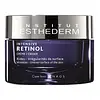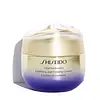What's inside
What's inside
 Key Ingredients
Key Ingredients

 Benefits
Benefits

 Concerns
Concerns

 Ingredients Side-by-side
Ingredients Side-by-side

Glycerin
HumectantCetearyl Isononanoate
EmollientCyclopentasiloxane
EmollientPropylene Glycol Dicaprate
EmollientDipropylene Glycol
HumectantPalmitamide DEA
Cetyl Palmitate
EmollientCetearyl Glucoside
EmulsifyingSqualane
EmollientC30-45 Alkyl Cetearyl Dimethicone Crosspolymer
EmollientRetinyl Palmitate
Skin ConditioningPolysorbate 60
EmulsifyingParfum
MaskingPentaerythrityl Tetra-Di-T-Butyl Hydroxyhydrocinnamate
AntioxidantSorbitan Isostearate
EmulsifyingCarnosine
Skin ConditioningTocopherol
AntioxidantLaminaria Digitata Extract
Skin ProtectingGlycerin, Cetearyl Isononanoate, Cyclopentasiloxane, Propylene Glycol Dicaprate, Dipropylene Glycol, Palmitamide DEA, Cetyl Palmitate, Cetearyl Glucoside, Squalane, C30-45 Alkyl Cetearyl Dimethicone Crosspolymer, Retinyl Palmitate, Polysorbate 60, Parfum, Pentaerythrityl Tetra-Di-T-Butyl Hydroxyhydrocinnamate, Sorbitan Isostearate, Carnosine, Tocopherol, Laminaria Digitata Extract
Water
Skin ConditioningButylene Glycol
HumectantDimethicone
EmollientGlycerin
HumectantAlcohol Denat.
AntimicrobialPPG-3 Dipivalate
Skin ConditioningGlyceryl Stearate Se
EmulsifyingCetyl Alcohol
EmollientPentaerythrityl Tetraethylhexanoate
EmollientHydrogenated Polydecene
EmollientMyristyl Myristate
EmollientPEG-100 Stearate
Silica
AbrasiveBis-Diglyceryl Polyacyladipate-2
EmollientPotassium Methoxysalicylate
BleachingBehenyl Alcohol
EmollientSodium Acrylate/Sodium Acryloyldimethyl Taurate Copolymer
Emulsion StabilisingStearyl Alcohol
EmollientPolyvinyl Alcohol
Phenoxyethanol
PreservativeIsohexadecane
EmollientParfum
MaskingPolysorbate 80
EmulsifyingSorbitan Tristearate
EmulsifyingTrisodium EDTA
Erythritol
HumectantPEG/PPG-14/7 Dimethyl Ether
Skin ConditioningPEG/PPG-17/4 Dimethyl Ether
Skin ConditioningTocopheryl Acetate
AntioxidantRosa Damascena Flower Water
MaskingSodium Citrate
BufferingSuccinoglycan
Skin ConditioningAlcohol
AntimicrobialSorbitan Oleate
EmulsifyingCaffeine
Skin ConditioningCitric Acid
BufferingSodium Metaphosphate
BufferingLavandula Angustifolia Oil
MaskingPhytosteryl/Octyldodecyl Lauroyl Glutamate
Skin ConditioningLimonene
PerfumingHexyl Cinnamal
PerfumingTocopherol
AntioxidantLinalool
PerfumingCitronellol
PerfumingSodium Metabisulfite
AntioxidantCI 77492
Cosmetic ColorantAngelica Acutiloba Root Extract
Skin ConditioningAngelica Keiskei Leaf/Stem Extract
Skin ConditioningOlea Europaea Leaf Extract
PerfumingLamium Album Flower/Leaf/Stem Extract
Skin ConditioningCellulose
AbsorbentCamellia Sinensis Leaf Extract
AntimicrobialInositol
HumectantCarthamus Tinctorius Flower Extract
Skin ConditioningCI 77491
Cosmetic ColorantZiziphus Jujuba Fruit Extract
Skin ConditioningRosmarinus Officinalis Leaf Extract
AntimicrobialHydrolyzed Silk
HumectantBupleurum Falcatum Root Extract
Skin ConditioningWater, Butylene Glycol, Dimethicone, Glycerin, Alcohol Denat., PPG-3 Dipivalate, Glyceryl Stearate Se, Cetyl Alcohol, Pentaerythrityl Tetraethylhexanoate, Hydrogenated Polydecene, Myristyl Myristate, PEG-100 Stearate, Silica, Bis-Diglyceryl Polyacyladipate-2, Potassium Methoxysalicylate, Behenyl Alcohol, Sodium Acrylate/Sodium Acryloyldimethyl Taurate Copolymer, Stearyl Alcohol, Polyvinyl Alcohol, Phenoxyethanol, Isohexadecane, Parfum, Polysorbate 80, Sorbitan Tristearate, Trisodium EDTA, Erythritol, PEG/PPG-14/7 Dimethyl Ether, PEG/PPG-17/4 Dimethyl Ether, Tocopheryl Acetate, Rosa Damascena Flower Water, Sodium Citrate, Succinoglycan, Alcohol, Sorbitan Oleate, Caffeine, Citric Acid, Sodium Metaphosphate, Lavandula Angustifolia Oil, Phytosteryl/Octyldodecyl Lauroyl Glutamate, Limonene, Hexyl Cinnamal, Tocopherol, Linalool, Citronellol, Sodium Metabisulfite, CI 77492, Angelica Acutiloba Root Extract, Angelica Keiskei Leaf/Stem Extract, Olea Europaea Leaf Extract, Lamium Album Flower/Leaf/Stem Extract, Cellulose, Camellia Sinensis Leaf Extract, Inositol, Carthamus Tinctorius Flower Extract, CI 77491, Ziziphus Jujuba Fruit Extract, Rosmarinus Officinalis Leaf Extract, Hydrolyzed Silk, Bupleurum Falcatum Root Extract
Ingredients Explained
These ingredients are found in both products.
Ingredients higher up in an ingredient list are typically present in a larger amount.
Glycerin is already naturally found in your skin. It helps moisturize and protect your skin.
A study from 2016 found glycerin to be more effective as a humectant than AHAs and hyaluronic acid.
As a humectant, it helps the skin stay hydrated by pulling moisture to your skin. The low molecular weight of glycerin allows it to pull moisture into the deeper layers of your skin.
Hydrated skin improves your skin barrier; Your skin barrier helps protect against irritants and bacteria.
Glycerin has also been found to have antimicrobial and antiviral properties. Due to these properties, glycerin is often used in wound and burn treatments.
In cosmetics, glycerin is usually derived from plants such as soybean or palm. However, it can also be sourced from animals, such as tallow or animal fat.
This ingredient is organic, colorless, odorless, and non-toxic.
Glycerin is the name for this ingredient in American English. British English uses Glycerol/Glycerine.
Learn more about GlycerinParfum is a catch-all term for an ingredient or more that is used to give a scent to products.
Also called "fragrance", this ingredient can be a blend of hundreds of chemicals or plant oils. This means every product with "fragrance" or "parfum" in the ingredients list is a different mixture.
For instance, Habanolide is a proprietary trade name for a specific aroma chemical. When used as a fragrance ingredient in cosmetics, most aroma chemicals fall under the broad labeling category of “FRAGRANCE” or “PARFUM” according to EU and US regulations.
The term 'parfum' or 'fragrance' is not regulated in many countries. In many cases, it is up to the brand to define this term.
For instance, many brands choose to label themselves as "fragrance-free" because they are not using synthetic fragrances. However, their products may still contain ingredients such as essential oils that are considered a fragrance by INCI standards.
One example is Calendula flower extract. Calendula is an essential oil that still imparts a scent or 'fragrance'.
Depending on the blend, the ingredients in the mixture can cause allergies and sensitivities on the skin. Some ingredients that are known EU allergens include linalool and citronellol.
Parfum can also be used to mask or cover an unpleasant scent.
The bottom line is: not all fragrances/parfum/ingredients are created equally. If you are worried about fragrances, we recommend taking a closer look at an ingredient. And of course, we always recommend speaking with a professional.
Learn more about ParfumTocopherol (also known as Vitamin E) is a common antioxidant used to help protect the skin from free-radicals and strengthen the skin barrier. It's also fat soluble - this means our skin is great at absorbing it.
Vitamin E also helps keep your natural skin lipids healthy. Your lipid skin barrier naturally consists of lipids, ceramides, and fatty acids. Vitamin E offers extra protection for your skin’s lipid barrier, keeping your skin healthy and nourished.
Another benefit is a bit of UV protection. Vitamin E helps reduce the damage caused by UVB rays. (It should not replace your sunscreen). Combining it with Vitamin C can decrease sunburned cells and hyperpigmentation after UV exposure.
You might have noticed Vitamin E + C often paired together. This is because it is great at stabilizing Vitamin C. Using the two together helps increase the effectiveness of both ingredients.
There are often claims that Vitamin E can reduce/prevent scarring, but these claims haven't been confirmed by scientific research.
Learn more about Tocopherol